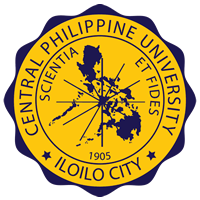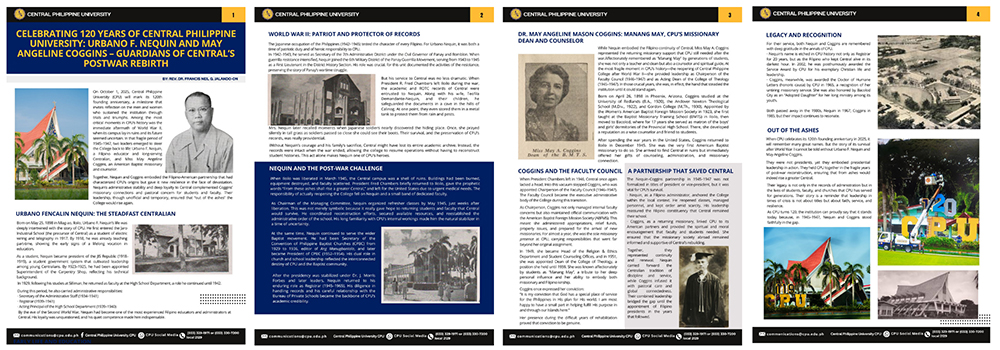By Rev. Dr. Francis Neil G. Jalando-on
Central Philippine University marks its 120th anniversary by honoring Urbano F. Nequin and Miss May Angeline Coggins for their pivotal leadership in restoring and guiding the university during its postwar recovery.
On October 1, 2025, Central Philippine University (CPU) will mark its 120th founding anniversary, a milestone that invites reflection on the men and women who sustained the institution through trials and triumphs. Among the most critical moments in CPU’s history was the immediate aftermath of World War II, when its campus lay in ruins and its future seemed uncertain. In that fragile period of 1945–1947, two leaders emerged to steer the College back to life: Urbano F. Nequin, a Filipino educator and long-serving Centralian, and Miss May Angeline Coggins, an American Baptist missionary and counselor.
Together, Nequin and Coggins embodied the Filipino-American partnership that had characterized CPU’s origins but gave it new resilience in the face of devastation. Nequin’s administrative stability and deep loyalty to Central complemented Coggins’ missionary connections and pastoral concern for students and faculty. Their leadership, though unofficial and temporary, ensured that “out of the ashes” the College would rise again.
Urbano Fencalin Nequin: The Steadfast Centralian
Born on May 25, 1898 in Miag-ao, Iloilo, Urbano F. Nequin’s life was deeply intertwined with the story of CPU. He first entered the Jaro Industrial School (the precursor of Central) as a student of electric wiring and telegraphy in 1917. By 1918, he was already teaching part-time, showing the early signs of a lifelong vocation in education.
As a student, Nequin became president of the JIS Republic (1918–1919), a student government system that cultivated leadership among young Centralians. By 1923–1925, he had been appointed Superintendent of the Carpentry Shop, reflecting his technical background. In 1929, following his studies at Silliman, he returned as faculty at the High School Department, a role he continued until 1942.
During this period, he also carried administrative responsibilities:
- Secretary of the Administrative Staff (1934–1941)
- Registrar (1939–1941)
- Acting Principal of the High School Department (1939–1940)
By the eve of the Second World War, Nequin had become one of the most experienced Filipino educators and administrators at Central. His loyalty was unquestioned, and his quiet competence made him indispensable.
World War II: Patriot and Protector of Records
The Japanese occupation of the Philippines (1942–1945) tested the character of every Filipino. For Urbano Nequin, it was both a time of patriotic duty and of heroic responsibility to CPU.
In 1942–1943, he served as Secretary of the 7th Administrative District under the Civil Governor of Panay and Romblon. When guerrilla resistance intensified, Nequin joined the 6th Military District of the Panay Guerrilla Movement, serving from 1943 to 1945 as a First Lieutenant in the District History Section. His role was crucial, for this unit documented the activities of the resistance, preserving the story of Panay’s wartime struggle.
But his service to Central was no less dramatic. When President R. Fred Chambers left Iloilo during the war, the academic and ROTC records of Central were entrusted to Nequin. Along with his wife, Teofila Demandante-Nequin, and their children, he safeguarded the documents in a cave in the hills of Calinog. At one point, they even stored them in a metal tank to protect them from rain and pests.
Mrs. Nequin later recalled moments when Japanese soldiers nearly discovered the hiding place. Once, she prayed silently in tall grass as soldiers passed so close she could see their boots. Their survival, and the preservation of CPU’s records, was really providential.
Without Nequin’s courage and his family’s sacrifice, Central might have lost its entire academic archive. Instead, the records were intact when the war ended, allowing the college to resume operations without having to reconstruct student histories. This act alone makes Nequin one of CPU’s heroes.
Nequin and the Post-War Challenge
When Iloilo was liberated in March 1945, the Central campus was a shell of ruins. Buildings had been burned, equipment destroyed, and faculty scattered. President Fred Chambers briefly returned to Iloilo, gave the prophetic words “From these ashes shall rise a greater Central,” and left for the United States due to urgent medical needs. The responsibility of actually reopening the College fell on Nequin and a small band of dedicated faculty.
As Chairman of the Managing Committee, Nequin organized refresher classes by May 1945, just weeks after liberation. This was not merely symbolic because it really gave hope to returning students and faculty that Central would survive. He coordinated reconstruction efforts, secured available resources, and reestablished the administrative order of the school. His long familiarity with CPU’s internal workings made him the natural stabilizer in a time of uncertainty.
At the same time, Nequin continued to serve the wider Baptist movement. He had been Secretary of the Convention of Philippine Baptist Churches (CPBC) from 1929 to 1936, editor of Ang Manugbantala, and later became President of CPBC (1952–1954). His dual role in church and school leadership reflected the interconnected destiny of CPU and the Baptist community.
After the presidency was stabilized under Dr. J. Morris Forbes and later leaders, Nequin returned to his enduring role as Registrar (1945–1965). His diligence in handling records and his careful relationship with the Bureau of Private Schools became the backbone of CPU’s academic credibility.
Dr. May Angeline Mason Coggins: Manang May, CPU’s Missionary Dean and Counselor
While Nequin embodied the Filipino continuity of Central, Miss May A. Coggins represented the returning missionary support that CPU still needed after the war.
Affectionately remembered as “Manang May” by generations of students, she was not only a teacher and dean but also a counselor and spiritual guide. At the most fragile moment in CPU’s history—the reopening of Central Philippine College after World War II—she provided leadership as Chairperson of the Faculty Council (1946–1947) and as Acting Dean of the College of Theology (1945–1947). In those crucial years, she was, in effect, the hand that steadied the institution until it could stand again.
Born on April 26, 1898 in Phoenix, Arizona, Coggins studied at the University of Redlands (B.A., 1920), the Andover Newton Theological School (M.Div., 1922), and Gordon College (M.Th., 1930). Appointed by the Women’s American Baptist Foreign Mission Society in 1923, she first taught at the Baptist Missionary Training School (BMTS) in Iloilo, then moved to Bacolod, where for 17 years she served as matron of the boys’ and girls’ dormitories of the Provincial High School. There, she developed a reputation as a wise counselor and friend to students.
After spending the war years in the United States, Coggins returned to Iloilo in December 1945. She was the very first American Baptist missionary to do so. She arrived to find Central in ruins but immediately offered her gifts of counseling, administration, and missionary connection.
Coggins and the Faculty Council
When President Chambers left in 1946, Central once again lacked a head. Into this vacuum stepped Coggins, who was appointed Chairperson of the Faculty Council (1946–1947). The Faculty Council became the executive administrative body of the College during this transition.
As Chairperson, Coggins not only managed internal faculty concerns but also maintained official communication with the American Baptist Foreign Mission Society (ABFMS). This meant she administered appropriations, relief funds, property issues, and prepared for the arrival of new missionaries. For almost a year, she was the sole missionary presence at CPU, carrying responsibilities that went far beyond her original assignment.
In 1949, she became Head of the Religion & Ethics Department and Student Counseling Offices, and in 1951, she was appointed Dean of the College of Theology, a position she held until 1959. She was known affectionately by students as “Manang May”, a tribute to her deep personal influence and her ability to embody both missionary and Filipino kinship.
Coggins once expressed her conviction:
“It is my conviction that God has a special place of service for the Philippines in His plan for His world. I am most happy to have a small part in helping fulfill His purpose in and through our Islands here.”
Her presence during the difficult years of rehabilitation proved that conviction to be genuine.
A Partnership that Saved Central
The Nequin–Coggins partnership in 1945–1947 was not formalized in titles of president or vice-president, but it was vital for CPU’s survival.
- Nequin, as a Filipino administrator, anchored the College within the local context. He reopened classes, managed personnel, and kept order amid scarcity. His leadership reassured the Filipino constituency that Central remained their school.
- Coggins, as a returning missionary, linked CPU to its American partners and provided the spiritual and moral encouragement that faculty and students needed. She ensured that the missionary society abroad remained informed and supportive of Central’s rebuilding.
Together, they represented continuity and renewal. Nequin carried forward the Centralian tradition of discipline and service, while Coggins infused it with pastoral care and global connectedness. Their combined leadership bridged the gap until the appointment of Filipino presidents in the years that followed.
Legacy and Recognition
For their service, both Nequin and Coggins are remembered with deep gratitude in the annals of CPU.
- Nequin’s name is etched in CPU history not only as Registrar for 20 years, but as the Filipino who kept Central alive in its darkest hour. In 2002, he was posthumously awarded the Service Award by CPU for his exemplary Christian life and leadership.
- Coggins, meanwhile, was awarded the Doctor of Humane Letters (honoris causa) by CPU in 1965, a recognition of her untiring missionary service. She was also honored by Bacolod City as an “Adopted Daughter” for her long ministry among its youth.
Both passed away in the 1980s, Nequin in 1967, Coggins in 1985, but their impact continues to resonate.
Out of the Ashes
When CPU celebrates its 120th founding anniversary in 2025, it will remember many great names. But the story of its survival after World War II cannot be told without Urbano F. Nequin and May Angeline Coggins.
They were not presidents, yet they embodied presidential leadership in action. They held CPU together in the fragile years of post-war reconstruction, ensuring that from ashes would indeed rise a greater Central.
Their legacy is not only in the records of administration but in the lives of students, faculty, and churches that CPU has served for generations. Their story is a reminder that leadership in times of crisis is not about titles but about faith, service, and resilience.
As CPU turns 120, the institution can proudly say that it stands today because, in 1945–1947, Nequin and Coggins stood faithfully in the gap.
References
Central Echo (various issues, 1946–1985).
Church Alive (1997).
Golden Jubilee Year 1905–1955 Souvenir Program.
Herradura, A., & Nelson, L. (1981). Scientia et Fides: The Story of CPU. Iloilo City: Central Philippine University.
Link (various issues, 1970–2000).
Archival documents from CPU Office of Communications

